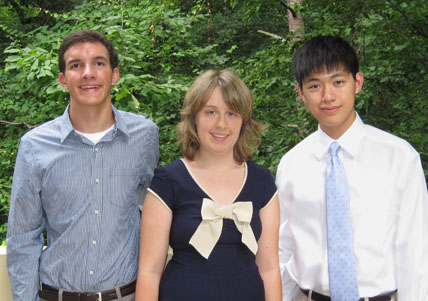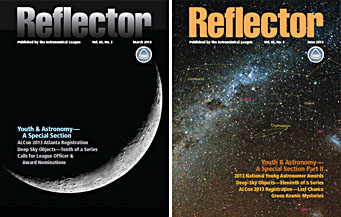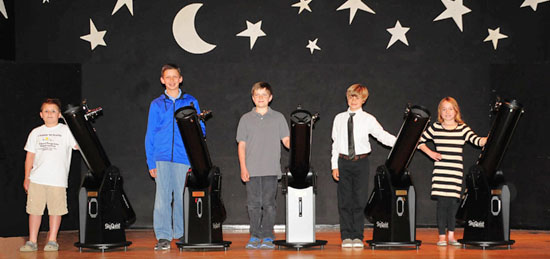For the past three decades, members of astronomy clubs have gradually gotten older and grayer. Now officers of the Astronomical League are getting serious about changing that trend.

Three teenagers received awards at the 2013 Astronomical League Convention in Atlanta. Left to right: Mark Moretto (1st place, NYAA); Sophia Lahey (Horkheimer/Smith Award); and Henry Lin (2nd place, NYAA).
S&T: Kelly Beatty
Mark Moretto is a high-school senior who persuaded comet expert Michael A'Hearn to let him help analyze results from NASA's Deep Impact mission. Initially skeptical, A'Hearn now admits that Moretto was "amazing, better than some of our grad students."
Henry Lin grew up in Shreveport, Louisiana — hardly a nexus of astronomical research. So he taught himself the intricacies of the Sunyaev–Zel'dovich effect (!) and how that might be applied to detecting dark matter in galaxy clusters.
Sophia Lahey, soon to start her senior year at Sir Francis Drake High School in Fairfax, California, doesn't look the part of a dark-sky warrior. But she's singlehandedly challenging local officials to adopt strict outdoor-lighting regulations to keep her hometown from being overrun with light pollution.

The 2013 Astronomical league Convention (ALCon) was held at Fernbank Science Center in Atlanta, Georgia.
Astronomical League
Although these three astro-achievers have very different backgrounds and interests, they have one thing in common: they were the only teenage attendees at this year's Astronomical League Convention (ALCon), which convened two weeks ago at Fernbank Science Center in Atlanta. Worse, they made the trip only because they'd won one of the League's annual awards.
All across the U.S., astronomy clubs are wrestling with the relentless aging of their members. Some of these "veterans" joined 40 or 50 years ago, as passionate youths eager to learn anything and everything astronomical. For many the interest is still there, but the passion is long gone. Today, most clubs would be thrilled to have a few teenagers or even 20- or 30-somethings in their midst.
To its credit, for 20 years the League has been trying to jump-start the next generation of stargazers with its National Young Astronomer Awards (NYAA), which these days includes a high-end Explore Scientific telescope and a sizable check. But clearly that's not enough of a draw. For example, the Amateur Telescope Makers of Boston (my local club) boasts 270 members. Yet only 10 of these are full-time students, and the membership rolls include just 22 families.
This is not a new problem, but it's becoming an urgent one for the League, which boasts 15,000 members in 250 affiliated clubs. So Ron Whitehead, the group's executive secretary, is spearheading an effort to find ways to bring younger astronomy devotees into the mix. "Young people today have plenty of choices," Whitehead notes, but increasingly those choices are "not to join an astronomy club or even to be interested in things astronomical."
John Goss, the League's vice president and coordinator of the NYAA program, is more blunt: "How do you approach teenagers who don't want to be in an old-man club?"

The March and June 2013 issues of The Reflector, published by the Astronomical League, offer a detailed look at the attraction of amateur astronomy to young people.
Astronomical League
A dozen perspectives on causes and solutions appear in the March and June issues of The Reflector. There Goss details some of the underlying issues: light pollution's theft of dramatically dark night skies, beautiful space- and ground-based imagery that creates unrealistic expectations at the eyepiece, and risk-averse parents' unwillingness to let their children explore the world with unstructured freedom.
One big problem, Whitehead told me, is that most older club members don't how to relate to a younger audience — or are uncomfortable doing so. There's the hurdle of learning how to navigate social media, he says, but also it's getting into the Millennials' mindset. In their fast-paced world, entertainment value is a big plus, while anything that smacks of science is often disdained. Telling them about your first dreamy-eyed view of Saturn through a 60-mm refractor doesn't cut it anymore.
Ron Schmit of the Minnesota Astronomy Society recently watched some college-age kids viewing the popular "Star Walk" astronomy app. "Check this out," said the iPhone's owner. "It shows you the constellations right here! Isn't that sweet?" Then he spun around in a circle as the sky wheeled by on the phone's screen. "Cool," another said. "What's that?" "Yeah, I don't know," shrugged the owner, who then clicked off the app and shoved the phone into is pocket. "The whole exchange took less than 15 seconds," Schmit says. "It felt like he was showing them his new yo-yo trick."
The Long Path Ahead
Fortunately, the League is getting useful feedback from some of its youngest members. "The issue comes down to money and information," explains Joshua Babin, 23, of the Houston Astronomical Society. With equipment being so expensive and the Internet overflowing with detail on every subject, "it is very easy to pass up astronomy and take up video games."
"As cliché as it sounds," advises 17-year-old Courtney Flonta, the very young president of Virginia's Back Bay Amateur Astronomers, "using technology is the best way to communicate with younger people. A nicely designed, easy-to-navigate club website is a must. And replace the boring PowerPoint lectures ("too much like school") with more engaging, hands-on activities.
"There's a high expectation for instant gratification — I hate saying that, but it's true," admits Lahey, who was honored in Atlanta with Horkheimer/Smith Award for service to the astronomical community. Still, she thinks her generation can be won over. "Kids are smart," Fahey told the attendees. "Just give them a chance."

Winners of the 2013 "Striking Sparks" essay contest, sponsored by the Sonoma County Astronomical Society in California. Left to right: Hunter Ward, Kade Crandall, Devon Bolt, Colton Rowe, and Estella Zea.
Len Nelson / SCAS
It's not that clubs are devoid of good ideas — and some of them do work. For example, since 1986 California's Sonoma County Astronomical Society has given away a total of 246 telescopes to local grade- and middle-school children through its Striking Sparks program. More recently, the New Hampshire Astronomical Society has kid-proofed dozens of Orion StarBlast reflectors and provided them to more than 70 libraries throughout the state. Goss thinks this Library Telescope Program could be rolled out nationwide.
I found lots of other solid ideas in those Reflector articles — everything from solar viewing at schools to providing transportation to and from star parties. But let's not confuse getting youngsters hooked on the night sky (relatively easy, methinks) and getting them to join a club (a long shot).
As Ted Forte of Arizona's Huachuca Astronomy Club sees it, the hobby can sustain itself without an infusion of young conscripts. Instead, the important thing is to plant seeds of interest that will sprout later in life. "If we see a lack of young members, maybe we are looking at it wrong," he says. "We should just see them as future old members."
So what do you think? Offer your experiences and suggestions in the comments below. (Trust me: the League's officers are eager to read them.)
 16
16
Comments
Tony Flanders
August 8, 2013 at 5:52 am
An important question is whether lack of young people in astronomy clubs reflects a lack of interest in astronomy or a lack of interest in joining clubs. I have little doubt that it's both, but I think the second may be more important. With communication increasingly electronic or in small groups of close friends, large-scale physical get-togethers seem sure to dwindle in all spheres of life. Which may not be a bad thing. Frankly, I've always found club meetings 20% inspiration and 80% tedium.
You must be logged in to post a comment.
Greg Scheiderer
August 8, 2013 at 9:35 am
I agree to a large extent with Tony. I have a life-long interest in astronomy but didn't become an active observer until I was in my 40s. My essay on my astronomy journey:
http://www.seattleastronomy.com/blog1/2013/05/getting-the-kids-interested-in-astronomy/
You must be logged in to post a comment.
Stephen Ramsden
August 8, 2013 at 10:36 am
Hmmm, there is something missing from this article about increasing astronomy awareness among students and the community, something about ALCON 2013, I cant put my finger on it...lol
You must be logged in to post a comment.
Robert Little
August 8, 2013 at 10:50 am
You get people to join more societies by getting more people to look up. You get more people to look up by being out there amongst them. We grumble about light pollution and what can be seen or not seen, then try to convince people that the only way to enjoy the heavens is by going out far from the city to truly dark skies. For many people, this simply isn't that practical. We can accomplish talking about the problem of light pollution while at the same time showing them what we can within urban and suburban environments. We need to almost take a guerrilla approach here ("guerrilla astronomy"... huh... I like that notion!). You get more people to see what they can, tell them what they're missing.
Another problem is that young people frequently cannot afford the equipment, and it is very discouraging when they do go to events and see very pricey tools. While there are a number of telescopes that qualify as inexpensive, we need to stop using lines like "the smallest telescope anyone should get is a 4"/6"/8" " etc. Many of us got into this avocation with what we would now shrug off as horrible gear, yet at that time it opened our eyes. We need to show what can be done with what can be had.
Amateur astronomy should not be limited strictly to certain economic strata. It should be open to all.
This way, you open the doors to all.
You must be logged in to post a comment.
Sean
August 8, 2013 at 11:37 am
When I stumbled across H. A. Rey's book "The Stars: A New Way to See Them" in the 6th grade, the skies were opened up to me. The alienating and abstract lines I'd glimpsed in other star charts fell away and were replaced by pictures in the sky. My best friend and I spent many late nights with the book and flashlights screened through red cloth on the hood of my mother's car. We learned the constellations and also about magnitudes, Messier objects and mythology. The first constellation I ever traced was Leo in May of 1985. The worthless, random line drawings of most star charts remain an obstacle to engaging with the stars. I've often wished it was possible to make Rey's versions of drawing the constellations a universal standard. They tore the roof off the world for me and pulled me out into the universe. The captured my imagination and fed my curiosity.
You must be logged in to post a comment.
Bill Biermann
August 9, 2013 at 12:00 pm
Not only is Astronomy experiencing a decline, but anything that has to do with Outdoors, and effort as well. So Scouting, hunting, and such are all on the decline.
I've noticed that "us" Astronomers have been "blaming" ourselves about this. STOP THAT !. I don't think it is our job to stand on our head, do cartwheels, and entertain. In the long run, our entertainment will not compete with the latest video games.
The biggest change has got to come thru by changing Parent behavior. The Game box is a great parent and babysitting tool. Parents or young adults have got to say "Enough" and find meaningful outdoor activities that are not 5 second Apps, but rather lifetime apps. Gimmicks will not work here. I've noticed the Homeschool crowd as a % tends to be more into youth astronomy, and that's because a parent push is needed.
There is nothing wrong about jazzing up Astronomy, of course. But working on a Messier list, or a Hershel list is hard work, and you can't get that done in 2 minutes, and the motivation has to come from within.
You must be logged in to post a comment.
Rose
August 9, 2013 at 3:00 pm
These are all great comments and address a variety of issues. I think that reaching out to the community with easy access to the sky is one great idea that is widely available.
I live in a small community and during the monthly Art Walk downtown the local club is out there with a wide variety of scopes including binoculars. As my community is very low income, myself included, this is a great way to interest people and show them that they don't really need anything but their eyes to engage in astronomy.
When I have the chance to talk to my friends who are interested or ask questions I always encourage them away from buying a scope and suggest using their eyes and binos first. I remind them that they will NOT see Hubble quality pictures but share my excitement about what they can see including galaxies, nebulae, shooting stars, various colors, etc. I led one very small star party and people were awed with easily findable objects like the coathanger asterism in the Summer Triangle.
I think that combined with making equipment more readily available, through loaner programs, the library (love that idea) and helping people learn how to use the equipment. I am not skilled with mechanics and still don't know how to use a telescope, yet I've seen wonders in the sky.
And I think that sharing that enthusiasm, that passion for the wonders in the sky is the ultimate way to reach the younger generations.
You must be logged in to post a comment.
George Reynolds
August 9, 2013 at 4:03 pm
I agree with Ted Forte, to sow the seeds in the young people, and we'll see results years down the road. As a kid I was always interested in science and astronomy, but didn't join a club until I was 55 years old! The demands of life, family, and career and the constraints of time and money caused me to have other priorities. When my five kids were grown and out of the house, I had some time and money to spend on myself, and I got into amateur astronomy and joined the Back Bay Amateur Astronomers.
Our club has a strong outreach program, taking our telescopes to the boardwalk at the Virginia Beach oceanfront once a month, May through September, monthly public skywatches at a local city park, and presentations to schools, libraries, churches, and Scout groups.
You must be logged in to post a comment.
Brian Reynolds
August 9, 2013 at 4:08 pm
It's a slippery slope this one. I believe that it isn't just one factor and that's the problem. Today's youth don't engage the world the way we used to and need to be approached differently. What that difference is is hard to quantify but having a separate kids meeting with only one or two adults would be a big help. I also believe that you have to plant the seeds today in hopes they sprout tomorrow, so to speak. This hobby, for many reasons, is given to exploring the world outside of ours at an older age. It's just the nature of the beast. I think the library idea, coupled with a contact person to help out, is one of the best I've heard of in awhile and I highly recommend it for starters. Re-writing and simplifying astronomy books might be helpful, too.
You must be logged in to post a comment.
Peter Jedicke
August 9, 2013 at 8:45 pm
Both the NYAA and the Striking Sparks are terrific ideas and I wish them every success. But if these programs have been underway for so many years, maybe the answers we are looking for can be found by following up on the past winners. Did any of them continue to pursue astronomy, either through their education or as a serious hobby? Their experiences might tell us what works! Perhaps we have this data already, and I just don't know about it.
You must be logged in to post a comment.
Alzie
August 10, 2013 at 3:47 pm
Well said.
As an aging amateur radio guy and amateur astronomer,
I m amazed at the parallels between these two pursuits.
As with dazzling on line images,
amateur radio suffers from
competing with easy instant communication thru the web.
It like - why bother doing it your self.
But that said, sites like Instructables etc.
give me hope that there still are
serious young DIYers out there who will carry on these wonderful traditions.
You must be logged in to post a comment.
Chuck Hards
August 12, 2013 at 11:21 am
40 years ago, at age 15, I was the only kid in the club.
It's the same today.
I'm still the only kid in the club.
You must be logged in to post a comment.
Nilesh
August 12, 2013 at 11:15 pm
I think most important reason is kids today are unable to relate. Primary reasons :
1. Dark skies are less and less accessible these days.
2. Less spare time when you just have to relax and do nothing and gaze the skies. So many distractions around. Imagine those days when there were no 24 hour TV or mobile or internet connection. You either had books which usually you were busy in the day time or in the library and the rest of the time you had was lay down on the porch and enjoy the heavens.
3. Curiosity is satisfied before imagination can even launch. With so easy access with your mobile too access information all the time, one really does not have to take trouble to you know find, discover and learn.
I am not against technology but these are changing times and perhaps the new generation will find there own inspiration for Astronomy which we the oldies are unable to relate.
You must be logged in to post a comment.
Frank Reed
August 15, 2013 at 1:35 pm
A commenter above mentioned H.A. Rey's book on the constellations. Sadly, that's almost quaint... The book in question was first published over sixty years ago, and it is about as "old-fashioned" as astronomy education can get. Meanwhile, just within the past five years, literally millions of people now have access to star-finder apps on their smartphones and tablets that make star identification almost trivial if you know a few basic tricks about how to use the device (resetting the built-in magnetic compass, for example). There are HUGE opportunities sitting right in front of us. But we have to look at the technology that is available today.
You must be logged in to post a comment.
Frank Reed
August 15, 2013 at 1:45 pm
I agree with Tony Flanders and others who have noted that traditional astronomy clubs can be boring and uninspiring. But then where are they? There are online alternatives which are equally "grey" if you poll the active members. I fear that the biggest quality we are failing to sell is "reality" itself. I get great pleasure personally from looking at the Orion Nebula through a telescope on a dark clear winter night and knowing that I am seeing the real thing, but I also know that it looks nothing like the photos and the imagery available online. This is nothing new though. Even fifty years ago, the photos of nebulae in popular astronomy books were misleading in that they were enhanced, long time-exposures. The Orion Nebula never would look like that from any point of view for any real observer. But there was formerly a philosophy that seeing a thing "for real", as it actually "is", mattered. This is now a much harder sell. So much of the imagery we encounter today is enhanced or even illusory that the desire to see Nature, inluding its celestial wonders, as it really is has almost disappeared. How do we pitch reality as a good thing?
You must be logged in to post a comment.
Dewey Barker
August 18, 2013 at 2:50 pm
I too agree with Ted Forte, we need to sow the seeds today in order to reap the harvest tomorrow. Like the Back Bay Amateur Astronomers, the Escambia Amateur Astronomers Association holds monthly public star gazes at Pensacola Beach from April to October. We also participate with our area school and scout group events. I believe that people participate in our activities when we are out in the publics view, but once they go home they get involved with other activities and we become unimportant. The one main factor, as I see it, is that we need to become more involved in the lives of the youth and the only way to do it involves time. We need to follow the examples and efforts put out by the coaches of the various youth sports. The coaches don’t meet with the youth once a month; they meet with them on an almost daily basis. At a minimum, we should be involved on a bi-monthly basis and those of you that are retired should be able to free up an hour or two every other week to begin sowing those seeds of interest. We need to volunteer at our schools and become mentors to the students and re-start school astronomy clubs. We need to begin working with our teachers and help them cover their astronomy lesson plans and show them that “old” does not mean inept or incapable. Once they know what "we" can do, they’ll be glad to invite "us" back. These efforts won’t provide an immediate increase in a waning membership now, but it will pay off at a later date and the only way to see the pay off for your efforts yourself is to begin now and not rely on someone else to do it.
You must be logged in to post a comment.
You must be logged in to post a comment.